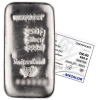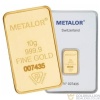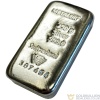Understanding the 1 oz Gold Bar: An Investor’s Guide

Gold bars have been a symbol of wealth and a form of investment for centuries. As we delve into the intricacies of the 1 oz gold bar, it’s important to understand its fundamentals, valuation, and the considerations to keep in mind when investing. This guide aims to equip investors with the knowledge needed to make informed decisions about incorporating gold bars into their investment portfolios.
Key Takeaways
- Gold bars are a tangible asset and come in various sizes, with the 1 oz gold bar being a popular choice for personal investment.
- The value of gold bars is influenced by market demand, geopolitical stability, currency values, and mining supply.
- Investing in gold bars can diversify an investment portfolio and serve as a hedge against inflation and currency devaluation.
- Purchasing gold bars requires careful consideration of authenticity, storage, and potential tax implications.
- Strategic investment in gold bars can involve analyzing market trends and deciding between long-term holding or short-term trading.
The Fundamentals of Gold Bars

Definition and Physical Characteristics
Gold bars, often referred to as gold bullion, are a form of physical gold that investors and collectors purchase for investment, collection, or as a hedge against economic uncertainty. Gold ounce bars are popular in the precious metals market, with their value derived from their gold content and purity. These bars are typically stamped with their weight, purity, and the mint’s mark.
Gold bars come in various sizes, but the 1 oz gold bar is particularly sought after for its balance of value and manageability. It is a standard unit for measuring gold, making it a convenient choice for investors. The 1 oz gold bar is recognized worldwide and is commonly included in investment portfolios, especially those aimed at retirement diversification through Self-Directed IRAs.
The 1 oz gold bar is a staple in the investment community, offering a combination of high purity and recognized value. Its size and weight make it an accessible option for both novice and experienced investors, providing a tangible asset that can be easily stored and traded.
The Role of Gold Bars in the International Market
Gold bars play a pivotal role in the international market as a vehicle for investment and a benchmark for wealth. Gold has been a symbol of value for thousands of years, and its allure continues in modern finance. The significance of 1 oz gold bars in investment portfolios is particularly notable due to their manageability and standardized weight, which facilitates global trade.
Gold bars, especially the 1 oz size, are favored for their ease of storage and transferability. They are often made with high purity levels, making them a preferred choice for investors seeking quality and reliability. The demand for gold bars ensures a consistent production, with various mints around the world creating bars that meet strict international standards.
Gold bars offer a unique opportunity to invest in an alternative asset that is not as volatile as stocks but can still provide valuable financial security.
Investors and collectors alike appreciate the variety of gold bar sizes available, but the 1 oz gold bar remains a staple in the market. It is a tangible asset that can be held outside of the traditional banking system, providing a sense of security during times of economic uncertainty.
Understanding Troy Ounces and Gold Measurements
When it comes to gold investment, understanding the measurement system is crucial. Gold content and purity are key in determining the value of 1 oz gold bars. The troy ounce is the standard unit for weighing precious metals, distinct from the avoirdupois ounce commonly used in the United States for other goods. One troy ounce is approximately 1.097 avoirdupois ounces, highlighting the importance of this distinction for investors.
Gold bars are available in a variety of sizes, which cater to different investment needs and preferences. The gramme format, for example, offers investors a range of sizes from the more modest one-gram bars to the substantial one-kilo bars. Here is a succinct table illustrating common gold bar sizes and their prices as of March 25, 2024:
| Gold Bar Size | Price (as of Mar. 25, 2024) |
|---|---|
| 1-ounce | $2,170.97 |
| 1-pound | $31,660.31 |
| 100-ounce | $217,097 |
| 400-ounce | $868,388 |
| 1-gram | $69.79 |
| 5-gram | $348.99 |
| 10-gram | $697.98 |
| 100-gram | $6,979.89 |
| 1-kilogram | $69,798.95 |
Karat purity and troy ounce weight affect investment value. It is essential for investors to be aware of these factors when assessing the worth of gold bars. The price of gold can fluctuate based on a multitude of factors, including market demand, geopolitical stability, and economic indicators.
Valuation of Gold Bars

Factors Influencing Gold Prices
The valuation of gold bars is subject to a complex interplay of market dynamics and economic indicators. Supply and demand are fundamental factors; the scarcity of gold can drive prices up, while an oversupply may lead to a decrease. Economic events play a significant role as well, with gold often considered a safe haven during times of financial uncertainty.
Market trends and economic factors such as interest rates, inflation, currency movements, and geopolitical events also have a profound impact on gold prices. For instance, rising inflation or a weakening currency can lead investors to seek refuge in gold, thereby increasing its demand and price. Conversely, a strong economy and stable geopolitical climate might reduce gold’s allure, potentially lowering its market value.
Investors should be aware of these variables and consider them when making decisions about gold investments. It’s crucial to conduct thorough research and understand personal risk-return preferences to effectively navigate the gold market. A strategic approach, including comparing dealers for lower premiums, can help in mitigating risks and maximizing returns.
Price Comparison of Different Gold Bar Sizes
The valuation of gold bars is directly influenced by their size and weight. Gold bars come in various sizes, ranging from 1 gram to 400 ounces, each with a distinct price point reflective of the current market value of gold. For investors, understanding the price differences between these sizes is crucial for making informed decisions.
Here is a succinct comparison of gold bar prices as of March 25, 2024:
| Gold Bar Size | Price (USD) |
|---|---|
| 1 oz | 2,170.97 |
| 1 lb | 31,660.31 |
| 100 oz | 217,097 |
| 400 oz | 868,388 |
| 1 g | 69.79 |
| 5 g | 348.99 |
| 10 g | 697.98 |
| 100 g | 6,979.89 |
| 1 kg | 69,798.95 |
The price per ounce or gram of gold can fluctuate based on a variety of factors, including market demand, geopolitical stability, and currency values. Investors should remain vigilant and stay informed of market trends to optimize their investment strategies.
1 ounce gold bars offer compact size and substantial economic value, making them sought-after investments. Investing in gold provides security and diversification in uncertain times.
Historical Price Trends of Gold
The historical price trends of gold reveal a fascinating journey of value, marked by periods of stability and sudden spikes reflective of global economic conditions. Gold’s price has risen dramatically in the past few decades, transforming it from a modest investment into a significant asset class. From an average price of less than $300 per ounce in 1999 to a price of $2,170.97 as of Mar. 25, 2024, the escalation in value is indicative of gold’s enduring appeal.
The price of gold is subject to fluctuations influenced by a myriad of factors, including market demand, geopolitical stability, and currency valuations. Notably, the price of gold in US dollars has decreased by 3% over the last year, while in sterling, it has increased by 10% due to currency strength variations.
The following table summarizes recent gold price movements:
| Date | Price per Ounce (USD) | % Change (Day) | % Change (Week) | % Change (Month) |
|---|---|---|---|---|
| Today | $2,170.97 | 0.64% | 4.67% | 10.24% |
| 1 Week Ago | $2,073.23 | – | – | – |
| 1 Month Ago | $1,969.45 | – | – | – |
Understanding these trends is crucial for investors navigating the gold market, especially when considering the purchase of 1 oz gold bars. The live gold price, often referred to as the "spot price," is a key indicator for investors and is updated frequently to reflect real-time market conditions.
Investment Considerations for Gold Bars

Diversification and Risk Management with Gold
Diversification is a cornerstone of sound investment strategy, particularly when it comes to precious metals like gold. By including 1 oz gold bars in a portfolio, investors can mitigate the risks inherent in market fluctuations and enhance the stability of their investment returns. Gold’s low correlation with other asset classes such as stocks and bonds makes it an effective hedge against economic downturns and inflationary pressures.
Investing in gold bars also requires consideration of factors such as liquidity and authenticity. Gold is highly liquid, meaning it can be easily bought and sold, but investors must ensure they are dealing with reputable sources to avoid counterfeit products. It is crucial to conduct thorough research and align gold investments with one’s financial goals to maximize the benefits of diversification.
While gold can provide a safe haven during times of economic uncertainty, it is important to balance the desire for security with the need for growth. Investors should weigh the pros and cons of gold investment against their individual risk tolerance and investment horizon.
Liquidity and Storage of Physical Gold
Investing in physical gold, such as bullion or coins, provides the investor with a tangible asset that can be held directly. However, the liquidity of physical gold can vary depending on market conditions and geographical location. Selling physical gold may involve additional costs and logistical challenges, including the need for secure storage and insurance.
While gold is a recognized store of value, offering protection against inflation and currency devaluation, investors must consider the practical aspects of holding physical gold.
The costs associated with storing and insuring gold should not be overlooked. For instance, the Royal Mint charges an annual management fee of 0.5% for its DigiGold products, which is generally lower than the 1-2% typically charged for physical gold storage and insurance. Here is a comparison of storage options:
- Home Safe: Personal control but higher risk of theft.
- Bank Safe Deposit Box: Increased security but limited access.
- Private Vault: Professional security and insurance, but at a cost.
- Gold Storage Services: Convenience and security, often with integrated insurance, but fees apply.
Investors must weigh the convenience and security offered by various storage solutions against the costs and accessibility of their gold investments.
Tax Implications and Capital Gains
Investing in 1 oz gold bars, like any investment, comes with its own set of tax considerations. Capital gains tax is a pivotal factor for investors to account for when buying and selling gold bars. In many jurisdictions, the profits from the sale of physical gold are subject to capital gains tax, which can significantly affect the net returns on investment. It is crucial for investors to understand the specific tax regulations that apply to gold investments in their region.
The tax treatment of gold investments can vary based on the form of gold and the duration of the holding period. For instance, certain UK bullion coins are exempt from Capital Gains Tax, offering a tax advantage for investors in these specific assets.
Understanding the tax implications is essential for a well-rounded investment strategy. Investors should consider sales tax, portfolio suitability, and entry barriers when investing in 1-ounce gold bars. Consulting with a tax advisor is highly recommended to navigate the complexities of tax laws and to optimize the investment for tax efficiency.
Purchasing Gold Bars

Where and How to Buy Gold Bars
Purchasing gold bars requires careful consideration of the source. Reputable dealers and retailers are the most reliable sources, often providing comprehensive services online. When selecting a dealer, it’s crucial to verify the authenticity, purity, and exact specifications of the gold bar.
For those considering alternative methods, options such as gold IRAs, gold ETFs, or precious metals mutual funds are available. These methods offer different approaches to incorporating gold into your investment portfolio.
While some U.S. banks may offer gold bars, availability is not universal. Prospective buyers should inquire with their bank and be prepared to present identification for the transaction.
The decision to invest in gold bars should be informed by a clear understanding of market trends and the implications of such an investment, including tax considerations.
Authentication and Certification of Gold Bars
When investing in 1 oz gold bars, authentication and certification are crucial to ensure the legitimacy of your investment. Reputable dealers will provide an assay certificate, which verifies the bar’s fineness and authenticity. This certificate should detail the bar’s exact weight, purity level, and the assayer’s official stamp.
Security measures include implementing protocols, safe storage, insurance, and counterfeit checks for 1 oz gold bars. Purity certification ensures fineness and authenticity with assay certificates.
It is also important to recognize the hallmarks of well-known producers. Some of the most trusted names in the industry include PAMP Suisse, Perth Mint, and Royal Canadian Mint. Each of these producers has a reputation for high-quality gold bars that meet strict standards of purity and weight.
To further safeguard your investment, consider additional security measures such as safe storage options and insurance against theft or loss. Counterfeit checks are another essential step in the authentication process, ensuring that the gold bars you purchase are genuine.
Investing in Gold Bars vs. Gold Coins
When deciding between investing in gold bars or gold coins, investors should weigh several factors. Gold bars are often favored for their straightforward value based on weight and purity, offering a more direct connection to the gold market price. They come in various sizes, from 1 gram to 1 kilogram, with the 1 oz gold bar being a popular choice for its balance of value and manageability. Gold coins, on the other hand, may carry additional value due to their design, rarity, and collector appeal, which can result in higher premiums over the spot price of gold.
Investors should consider market familiarity, investment experience, sizes, and inflation hedging when buying a gold bar. 1 ounce gold bars offer diversification, high purity, low premiums, and various sizes for investment flexibility.
Here’s a comparison to help illustrate the differences:
- Gold Bars: Typically lower premiums, larger variety of sizes, straightforward valuation.
- Gold Coins: Potential collector value, historical significance, aesthetic appeal.
Ultimately, the choice between bars and coins will depend on the individual’s investment goals, liquidity needs, and interest in the collectible aspect of gold. While bars are suited for pure investment purposes, coins can provide an additional hobbyist or collector angle to the investment.
Strategic Approaches to Gold Investment

Long-term vs. Short-term Gold Investment Strategies
Investors often grapple with the decision of whether to pursue long-term or short-term strategies when investing in gold. Long-term investment strategies typically involve buying and holding gold for several years, capitalizing on the metal’s historical tendency to maintain or increase in value over time. This approach is often favored by those seeking to hedge against inflation and currency devaluation.
Conversely, short-term investment strategies focus on capitalizing on market volatility. Investors who engage in short-term trading aim to buy low and sell high in shorter intervals, which requires a keen understanding of market trends and a readiness to act swiftly on market signals.
Both strategies have their merits and risks, and the choice largely depends on the investor’s financial goals, risk tolerance, and market outlook.
Here are some considerations for each strategy:
-
Long-term investment:
- Hedge against economic uncertainties
- Potential for steady appreciation
- Lower transaction costs due to infrequent trading
-
Short-term investment:
- Opportunities for quick profits
- Higher transaction costs due to frequent trading
- Requires active market monitoring and quick decision-making
Analyzing Market Signals for Gold Investment
Investors seeking to optimize their gold investment strategies must be adept at analyzing market signals. Understanding macroeconomic trends is crucial, as these can significantly impact gold prices. Factors such as inflation rates, currency fluctuations, and central bank policies are key indicators that can suggest the right time to buy or sell gold.
- Inflation rates often correlate with gold prices, as gold is seen as a hedge against inflation.
- Currency strength, particularly the US dollar, can inversely affect gold prices.
- Central bank decisions regarding interest rates and monetary policy can drive gold markets.
It is imperative for investors to remain vigilant and responsive to these signals, adapting their strategies to align with current market conditions.
Additionally, geopolitical risks and economic outlooks play a substantial role in shaping investor sentiment. By staying informed and conducting thorough research, investors can mitigate risks and maximize returns, ensuring a more secure and profitable gold investment journey.
Incorporating Gold into a Balanced Investment Portfolio
Incorporating gold bars into an investment portfolio is a strategic move that can enhance diversification and mitigate risk. Gold’s unique characteristics make it a valuable asset for balancing against the volatility of stocks and bonds. When considering the addition of gold to a portfolio, investors should evaluate several factors to ensure a well-rounded investment strategy.
- Purity: The fineness of the gold is crucial, as it affects the value and marketability of the gold bars.
- Authenticity: Ensuring the gold bars are certified by reputable sources is essential to avoid counterfeit products.
- Buying Strategies: Deciding on the timing and method of purchase can significantly impact the overall investment outcome.
A balanced portfolio with gold bars should be structured with a long-term perspective, taking into account the historical stability of gold as an asset class. This approach can provide not only wealth preservation but also potential growth over time.
Conclusion
In summary, the 1 oz gold bar represents a tangible and enduring asset that offers investors a unique opportunity to diversify their portfolios beyond traditional investments like stocks and real estate. With its intrinsic value and historical significance, gold continues to be a sought-after commodity in the global market. As we have explored, understanding the nuances of gold bar sizes, pricing, and investment strategies is crucial for anyone looking to invest in gold. Whether you are a seasoned investor or new to the world of precious metals, the insights provided in this guide aim to equip you with the knowledge necessary to make informed decisions about gold investments. Remember, the value of gold can fluctuate, so it is important to stay informed and consider all factors before making any financial commitments.
Frequently Asked Questions
What is a gold bar and how is it used in the international market?
A gold bar is a refined metallic gold that has been cast into a bar shape. It’s a recognized standard for trading on the international gold market and is often held as a reserve asset by governments and central banks.
How is the price of a 1 oz gold bar determined?
The price of a 1 oz gold bar is influenced by the current spot gold price, which reflects the market’s supply and demand for gold. As of March 25, 2024, one ounce of gold is worth $2,170.97.
What factors can affect the price of gold?
Gold prices can be affected by various factors such as geopolitical stability, inflation rates, currency values, interest rates, and market demand for precious metals.
Is investing in gold bars a good way to diversify my portfolio?
Investing in gold bars can be a strategic way to diversify your investment portfolio as it often has a negative correlation with other asset classes, providing a hedge against market volatility.
What are the differences between investing in gold bars and gold coins?
Gold bars are typically favored for their lower premiums over spot price compared to gold coins, which may carry additional value due to their collectibility, design, and legal tender status.
What should I consider when it comes to the storage and security of gold bars?
When storing gold bars, consider security features like safes or deposit boxes, insurance for your investment, and potential storage fees if opting for a professional storage facility.










